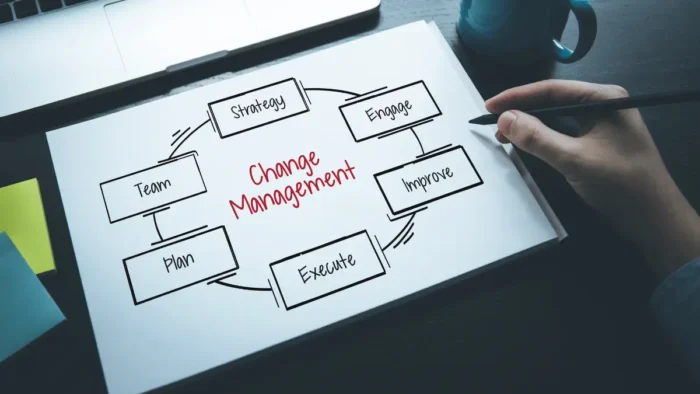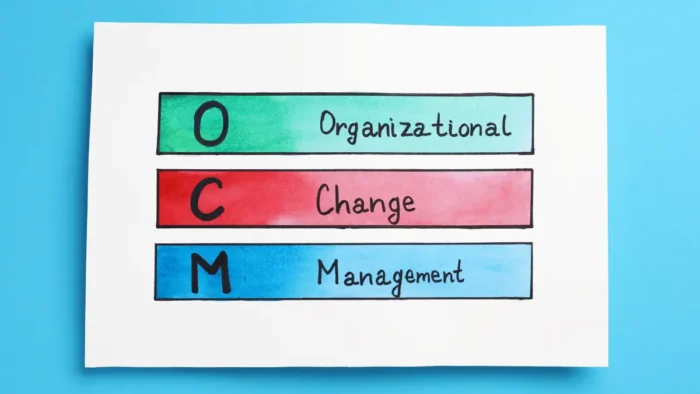Change management is critical in organizational development, from adapting to technological advancements to responding to market shifts. This article is part of our series about different change management models. Previously, we described the diagnostic organizational change model. which is a structured and strategic approach to making organizational change based on the diagnosis of organizational performance.
Understanding and utilizing Kotter’s model can be the difference between successful transformation and wasted organizational efforts.
What is Kotter’s 8-Step Change Model?
Kotter’s 8-Step Change Model, also known as Kotter’s change management model or Kotter’s change model, is a complete step-based process for implementing and managing organizational change. The model is designed to help change leaders successfully manage all the complexities of the change process and highlights the importance of building urgency and motivation between team members.
The model aims to implement and manage change and instill a culture of adaptability by encouraging leaders to view change as an ongoing journey rather than a one-time event.
The origins of Kotter’s 8-step change model can be traced back to the work of John P. Kotter, a renowned Harvard Business School Professor. He is the Konosuke Matsushita Professor of Leadership, Emeritus at Harvard Business School, and co-founder of Kotter International.
He introduced this transformative model in his 1995 book “Leading Change” after years of extensive research into organizational behavior while implementing change processes.
The model highlighted the need for proactive change to ensure long-term organizational sustainability.
Kotter’s model’s power lies in its simplicity and clarity, and focuses on the biggest obstacle inside the organizational change implementation process: overcoming resistance to change above all. It consists of only eight key steps. Each stage inside the model is essential to the success of your change efforts and forms a crucial part of the change management process, including optimizing organizational processes.
8 Steps of Kotter’s Change Model
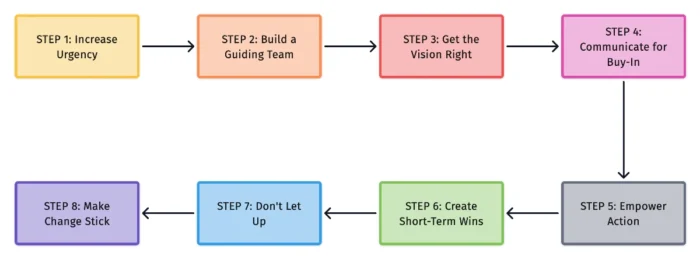
Kotter’s 8-step change model is a checklist for organizational change and goes deep into the psychology behind it. It addresses the tendency inside organizations to prefer the status quo and the need for compelling motives to drive change.
Let’s discuss the model’s different stages for implementing organizational changes.
1. Creating a Sense of Urgency for Organizational Change Process
The first step in Kotter’s model, “Creating a Sense of Urgency,” is necessary to start the engines of organizational change implementation and achieve lasting transformation. It involves answering the following question: Why is the proposed change necessary for organizational growth? The answer creates the initial motivation to start the process of change.
Without urgency, the status quo is powerful, and soon, people will become more willing to resist departure from the current situation.
If you create urgency and effectively communicate the rationale behind the necessary changes, employees will be prepared for the upcoming transformations and encouraged to participate in them.
The art of showing a strong urgency lies in storytelling that describes the current challenges and outlines the urgent need for change. This approach can fuel discussion and understanding, cultivate a shared understanding of urgency, and also motivate the organization to mobilize for the change initiative.
But the question is how you can start the engines or how you can create a sense of urgency. Here are some strategies to help you effectively build the urgency:
- Share important insights and data highlighting how the market, technology, and competition are shifting and require implementing change.
- Clearly outline the potential risks and threats if changes are not implemented, making the need for action more tangible.
- Share success stories and examples of competitors who have successfully implemented changes and how they have benefited.
- Use clear and impactful visualization tools to illustrate the gap between the organization’s current and desired state after implementing change.
2. Form a Guiding Coalition for Leading Change
The second step in Kotter’s model is forming a guiding coalition, and it recognizes that change cannot be driven by a single individual, no matter how influential they might be.
Instead, this step requires a diverse team of influential stakeholders and leaders who can support, influence, and lead the change initiative.
Remember that diversity is the key to building a great guiding coalition. The coalition should include members from different departments and levels within the organization. This diversity provides a balanced mix of leadership vision, strategic expertise, and managerial skills.
Let’s look at some ideas on how you can implement this step in the model:
- Look for leaders and influential figures with a mix of skills, experiences, and positions within the company who can drive and support implementing organizational-wide change.
- Ensure that the people you consider for your coalition are genuinely committed to the change. This means that senior management demonstrate strong dedication to organizational changes.
- For the coalition to be effective, its members must have the necessary resources and authority to lead change.
- Encourage your coalition to work closely together, fostering a sense of trust and friendship.
3. Developing Vision and Strategies

Change needs a clear direction. Leaders and the coalition must articulate an aspirational and achievable vision. This vision outlines the change’s objectives and the organization’s path, providing clarity and purpose to all involved.
Because of that, in the third step of Kotter’s change model, “developing vision and strategies,” leaders are tasked with:
- Formulating a clear and inspiring vision for change
- Creating a vision that guides the organization’s actions and keeping the change efforts on track
- Ensuring the vision is short, engaging, and focused
- Effectively communicating how the identified problems will be solved
After all, you must also ensure that the vision aligns with the organization’s core values and goals, which is fundamental to maintaining coherence throughout the change. A strategic vision that describes how the future will differ from the past and the initiatives linked to this vision can effectively drive change.
4. Communicate the Change Vision
A clear vision regarding change initiatives will only be effective if it is shared between organizational members.
Kotter’s model’s fourth step, “communicating the vision,” highlights the significance of effective communication in influencing the organizational members about the need for change.
This step ensures that organizational change’s “why” and “how” are understood and internalized at all organizational levels.
Visual aids and demonstration of desired behaviors can ensure that the organization clearly understands and adopts a clear and appealing vision.
5. Removing Obstacles
One constant of all organizational changes is always resistance. This resistance can take various forms, from employees sticking to old work methods to outdated organizational processes slowing the adoption of new practices.
So, the fifth step of this change management model, “removing obstacles,” addresses these challenges head-on.
Change leaders play a key role in this stage because they must:
- Demonstrate behavior that aligns with the vision
- Identify and remove all possible barriers to change
- Address employee concerns openly and offer solutions
- Empower employees to adopt new ways of working
Quick action in this stage will ensure success, as it helps to implement change effectively.
6. Generate Short-Term Wins

Remember that celebrating small victories along the way can increase morale and maintain momentum above all else. Kotter’s sixth step recognizes the power of early and small milestone achievements and successes to inspire persistent effort from all team members and employees.
Early successes prove that change is possible and beneficial, so celebration will increase employee morale and support the vision.
To achieve short-term wins, all change leaders should:
- Have visible and clear goals that will be directly linked to the change initiative
- Celebrate all the first victories of the change initiative
- Recognize those who actively support and help implement the change
These actions can build and sustain the momentum for organizational changes.
7. Consolidate Gains and Produce More Changes
After the initial wins are achieved, it’s time to capitalize on momentum and produce more change.
The seventh step of Kotter’s change model involves capitalizing on already generated momentum by early small victories and using these successes to implement bigger, more substantial changes.
So, maintaining focus and continuing efforts is crucial even after achieving initial successes. Change leaders must:
- Consolidate the gains from change initiatives
- Implement necessary changes in policies and systems
- Ensure that the change becomes a permanent part of the organizational culture and operations
This continuous improvement ensures that the change becomes a permanent part of the organizational culture and operations.
8. Anchoring Change in Organizational Culture

The final step of Kotter’s change model, “anchoring change in organizational culture,” involves making new ways of working the “new normal.” It involves integrating the new organizational norms, values, and practices into the organizational culture.
Change leaders also play a critical role in this stage. They must continuously support change and ensure that the values behind the new vision are evident in day-to-day work. This ongoing support, combined with formal recognition of the transition, ensures that the change is firmly rooted in the corporate culture.
Organizational systems, structures, and values must reflect new practices and beliefs.
Tools You Can Use to Apply Kotter’s Process Effectively
To successfully apply Kotter’s 8-step change model, you must use strategic tools and approaches that align with each step of the model. Let’s look at what tools you can use:
Step One: Urgency
To apply the first step of Kotter’s change model, you must focus on the urgency. Different tools can help you identify, communicate, and act on critical organizational needs.
Here are some tools that can be used for this step of the process:
- Surveys and questionnaires can collect data about employee perceptions and gaps and highlight areas requiring immediate action.
- SWOT analysis (Strengths, Weaknesses, Opportunities, Threats) can help you identify external opportunities and threats that require urgent change, as well as internal strengths to use and weaknesses to eliminate. Here are four steps to conducting a SWOT analysis.
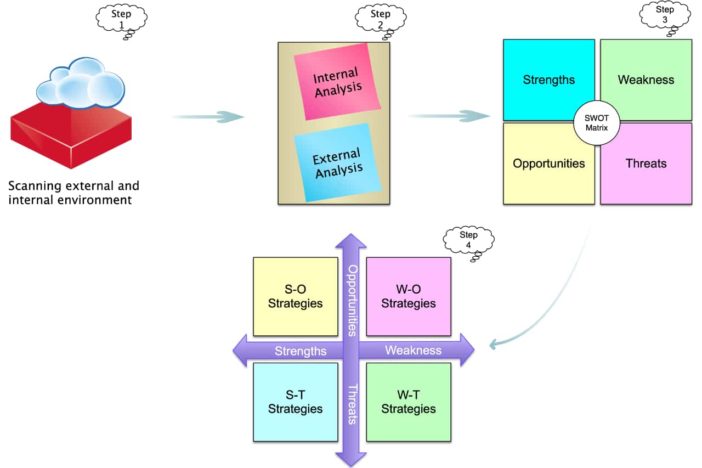
- Benchmarking to compare your organization’s performance against industry leaders can highlight areas of underperformance and identify an existing problem that highlights the urgency for change.
- Social media listening tools can help you track what customers, competitors, and the market say about your industry.
- Digital dashboards can visualize key performance indicators (KPIs) and real-time trends, helping you stress the immediate need for action in specific areas.
- Change readiness assessments can help you evaluate how prepared your organization is for change, identifying urgency from a strategic and operational perspective.
Step Two: Guiding Coalition
Using the right tools to effectively build a guiding coalition, as the second step in Kotter’s change model, can help you identify, engage, and empower key persons within your organization.
Here are some tools that can be helpful for this step:
- Leadership assessment tools can help you identify individuals with the leadership skills necessary to drive change.
- Cross-functional workshops will bring together potential change agents from across the organization.
- Stakeholder engagement maps can help you identify key stakeholders and assess their levels of influence and interest to successfully implement change.
- 360-degree feedback systems will help you get insights about potential coalition members from their peers, subordinates, and superiors.
Step Three: Vision and Strategies
When it comes to the third step of this model, here are several tools that can be highly useful:
- Visual mapping tools, such as mind maps, flowcharts, and infographics, can help you and all organizational members to articulate complex visions and strategies clearly and accessible.
- Strategic planning workshops will engage key stakeholders in strategic planning sessions and facilitate the clear definition and alignment of the vision and strategic priorities.
- Vision boards visually represent the desired future state and can inspire and align team efforts. They can be used in workshops and meetings to keep the focus on the change process’s comprehensive goals.
- Goal-setting frameworks like SMART goals or OKRs establish clear, measurable, and time-bound goals aligned with the vision statement and strategies.
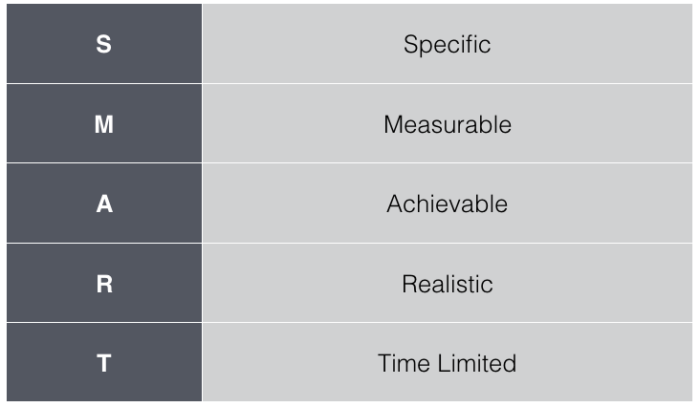
Step Four: Change Vision Communication
Communicating the change vision effectively ensures buy-in and commitment from all stakeholders. Here are tools that can help you implement this crucial step:
- The change communication plan will outline how and when the vision and strategies will be communicated across the organization.
- Organizational communication channels such as email, intranets, meeting minutes, company social networks, and messaging apps will help you disseminate change vision messages across the organization.
- Interactive Q&A sessions are great for addressing important concerns, clarifying the vision, and promoting two-way communication.
- Training programs that educate and connect the specifics of the change to the vision will ensure a clear understanding and alignment.
Step Five: Obstacles
Many tools and strategies can help you identify and overcome barriers to change. Here are several of them:
- Problem-solving sessions where employees can openly discuss challenges and collaboratively find solutions can help identify and remove obstacles.
- Process re-engineering tools can help you analyze and redesign processes to eliminate inefficiencies that may delay change.
- Conflict resolution strategies can help address interpersonal or departmental resistance to change.
- Change advocacy groups can help you identify roadblocks and advocate for solutions among their peers.
- Barrier analysis identifies and categorizes potential or existing barriers or obstacles to change, allowing the implementation of targeted intervention strategies.
Step Six: Creating Short-Term Wins
Identifying and communicating short-term wins is crucial for maintaining momentum in the change cycle. The following tools and strategies can be instrumental in recognizing and leveraging these successes:
- Performance metrics and KPIs can help set clear, quantifiable targets that can be reviewed regularly to identify achievements in the early stages of your change initiative.
- Dashboards and scorecards will help you visualize performance against set goals in real-time, making identifying and communicating short-term wins easier.
- Internal newsletters and bulletins communicate progress, celebrate successes, keep the momentum alive, and inform the whole organization about the change’s positive impacts.
- Celebration events, whether virtual or real, to celebrate achievements promote a sense of community and acknowledge the efforts of those involved in the change process.
Step Seven: Consolidate Gains and Produce More Changes
To effectively consolidate gains and produce more changes in Kotter’s change management model, you can utilize a combination of different tools:
- Continuous improvement workshops can help you identify additional opportunities for change and improvement, building on earlier successes’ momentum.
- Leadership development programs will equip change leaders with the necessary skills to manage ongoing and future changes.
- Success Case Method (SCM) is a framework for systematically identifying and communicating individual and team successes that might otherwise go unnoticed, reinforcing the value of the changes made.
- Innovation labs or hubs are physical or virtual spaces dedicated to generating innovative ideas and solutions that align with the change vision, fostering a company culture of continuous improvement.
Step Eight: Anchoring Change in Organizational Culture
Here are tools that can facilitate this final step in Kotter’s change model:
- Culture assessments will evaluate the alignment of current practices with the desired culture, identifying gaps and areas for improvement.
- Recognition and reward systems that align with the new values and behaviors will strengthen change adoption.
- Leadership role modeling is where leaders consistently manifest the behaviors and attitudes integral to the new culture, setting a visible example for the rest of the organization.
Advantages and Disadvantages of Kotter’s 8-Step Model
While this model offers a detailed and comprehensive framework for change, it’s not the only one. Other change management models, such as Lewin’s 3-stage model, the Lewin-Scheins model, the diagnostic model, and the ADKAR Model, also provide valuable insights into the change management process.
Despite their differences, all change models share a common goal – to guide an organization’s management through the challenging change project.
However, in my experience, no model is perfect, and Kotter’s 8-step change process is no exception. Still, its strengths outweigh its weaknesses in most cases.
The model’s straightforward and clear description of the change process enables easy implementation, and its emphasis on stakeholder engagement in the early stages ensures overall acceptance and support for change.
On the other hand, the model’s sequential nature and linear approach can be time-consuming and risky, leading the team to skip some steps. Also, even though the last step is anchoring change, many managers think it is the last step because of the high level of linearity, not something that will require starting the new change cycle.
The top-down approach often restricts employee participation, potentially leading to staff frustration. Nonetheless, these challenges can be managed with thoughtful implementation and continuous feedback.
Conclusion
Change management is an art guided by methodologies like Kotter’s. In an era where change is the only constant, companies that master it will always be at the forefront of the market.
This change model provides structure and vision for leaders and practitioners who navigate change’s unpredictability.
So, get ready and start making your company adaptive because today, the most adaptive organizations will survive.


